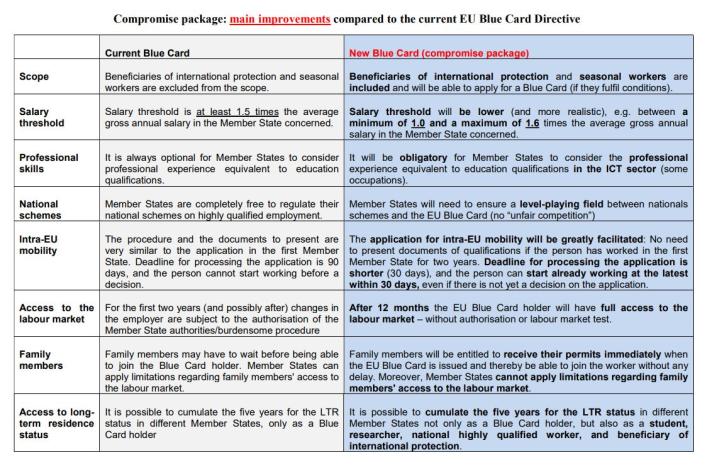Every year the European population is growing, with 1 – 1,5 million who are coming and staying. Most for family reasons, studies or job, some for protection. Legal migration is this week’s blog topic, specifically legal migration for economic reasons. Legal pathways for protection will be a separate blog post in a few weeks’ time.
Firstly, after four editions, I want to thank all of you who have given feedback to my #TimeToDeliverMigrationEU blog. You are a very informed and growing audience and clearly one that wants to see a long-term system that takes migration out of the headlines precisely because we have built a more functional European system.
This audience understands that part of that normalisation of migration is to show that we are invested in developing legal pathways for those coming to the EU. Those legal pathways can be for the long term, for study, for experience. They can equally be for shorter periods, with the aim of taking that experience back to their country of origin, something we call ‘circular migration’. Legal migration to the EU is largely successful but as with a lot of topics, controversy sells and the successes tend to be quietly ignored.
But legal migration is a success and it is needed, since Europe has an aging population. Indeed the Conference on the future of Europe is looking at the topic of migration in this context.
Across the EU there is a deficit in health care workers, in care workers, in skilled trades, engineers, technicians and IT professionals and also occupations with less formal skills, e.g. sales representatives and drivers. So the need for legal economic migration is clear.
But arrivals to the EU has to be managed safely, securely and strategically. If that is achieved, we build confidence in the system and therefore the future.
With the Pact on migration I want to prevent irregular migration on dangerous routes, as I mentioned in my last blog, and instead open up more legal ways to the EU.
Legal pathways for migration are the procedures allowing non EU-citizens to settle regularly in the European Union, be it for family, for work, for study, with the aim of building a life here, or often, taking skills back to their country of origin.
There are a lot of individual Member States systems providing legal pathways but more EU-led coordination means more transparency and predictability.
A step forward was on 17 May when the Commission, the Parliament and the Council reached an agreement on the revised Blue Card Directive. Which are new rules for the entry and residence of highly skilled workers from outside the EU.
You can see a table of what is new at the bottom of this blog.
The new Directive aims at attracting highly skilled talent. The new scheme will introduce more flexible admission conditions, enhanced rights and the possibility to move and work more easily between EU Member States. Change includes among others a more reasonable salary threshold, the possibility to apply for beneficiaries of international protection and seasonal workers. Family members of EU Blue Card holders will be able to accompany them and access the EU labour market.
The new pact on migration also promotes legal migration to the EU by setting up a new Skills and Talent package.
The package will include a revision of the Directive on long-term residents that will improve the EU long-term residence status. This will allow migrants who are already well integrated in one Member State, to move more easily to other Member States, to work or study. The improvement will be beneficial not only for migrants but also for employers, for whom it will be easier to hire migrants from the whole of the EU to fill in labour shortages.
The package will also include a review of the Single Permit Directive, to simplify the admission and residence conditions for third-country workers who do not fall under the ‘highly-skilled' category. This will grant workers of different skills levels access to an easier and quicker procedure to apply for a combined residence and work permit, and also better protection from the risk of labour exploitation.
To promote tailor-made and mutually-beneficial international legal migration and mobility the pact foresees setting up Talent Partnerships with key third countries. I will host a high-level conference on 11 June to discuss this. These partnerships will support - including financially - the mobility of people to the EU for study, training, and work, while relying on close cooperation of authorities, labour market institutions, employers, social partners, and education and training providers. They could also provide partner countries with assistance for capacity building e.g. on labour market or skills intelligence. The Talent Partnerships will be based on real labour and skills needs of both the EU and partner countries. At the same time, they would be one of the tools the EU could use to engage partner countries strategically on migration.
The Commission will also explore the options of how to set up an EU Talent Pool, an EU-wide platform for international recruitment. The platform will allow skilled non-EU workers to express their interest in migrating to the EU, and could be identified by EU migration authorities and employers based on their needs.
The way forward for legal migration is not one single highway, rather many different pathways.
And it is an integral part of my proposals. As I often say, migration is normal, irregular pathways though must be avoided and legal pathways, if done well, are the route to a sustainable economic future.
This is a weekly blog outlining the benefits of the proposals on migration tabled by the European Commission on 23 September 2020. For more detail New Pact on Migration and Asylum | European Commission (europa.eu)
Details
- Publication date
- 30 May 2021
- Author
- Directorate-General for Communication


